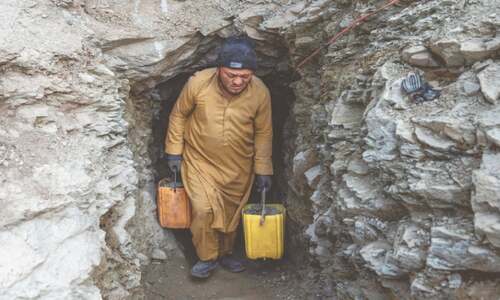YAFTAL SUFLA: In a momentary break from the noise of the equipment he and a dozen other men were using to mine for gold on a mountaintop in northeastern Afghanistan, Homayon tore off a piece of moldy flatbread and gulped down tea.
The 30-year-old joined forces with other jobless guys to try their luck making a life in the steep mountains that dominate Badakhshan region after finding little success as a mechanic in neighboring Faizabad city.
“We came here to see if we can find anything,” Homayon remarked as the few guys wrapped up their break and went back to work at the makeshift mine they had established. “Five, six of us were jobless.”
Even though they spend a lot of money on labor, gasoline, and equipment, their four tunnel excavation projects have yielded little results. According to Homayon, the promise of a windfall outweighed the hazards of debt, so they continued digging because other mines in the region had proven productive.
The other miner, Qadir Khan, cautioned that the losses might be substantial. “Someone got into debt because they couldn’t find anything from these kinds of tunnels,” he remarked.
“After losing between two and three hundred thousand (Afghanis, or roughly $2,800 and $4,200), all they could do was try to find another job, earn some money, and return to pay off their debts.”
Sorting through the rocks
Khan, who is seventy-four, says he has to work on despite his age. He is hunching over a pile of pebbles and breaking them into smaller pieces.
Two decades of war with the United States and its allies may have ended with the Afghan Taliban’s control of the nation in 2021, but a World Bank analysis indicates that half of the population still lives in poverty.
60-year-old laborer Sharif said he had kept animals in the past but had been mining for the past year. His two sons had gone to work in Iran.
“We are still farming, but it is not the way it used to be,” he remarked, lamenting the recent drought-stricken Afghanistan’s lack of water.
The boulders that Sharif assists in mining are crushed, thrown down the sheer cliff, and ground into a fine powder that resembles flour.
Men are using improvised buckets to collect water from mounds of powder on the banks of the Kokcha River, which meanders between snow-capped peaks.
After that, it is sieved as it passes through a sluice lined with material taken from automobile interiors.








